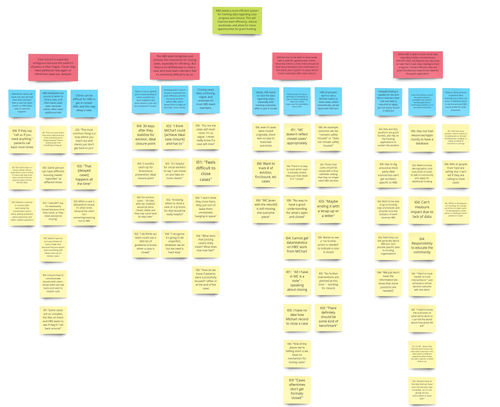Defining Case Closure for hbs
This professional consulting project offers recommendations for our client HBS at Michigan Medicine, to close cases using our UX Research and contextual inquiry methods.
Please click here to view the detailed report.

Figure 1. Affinity wall for the HBS project
About
Research
Analysis
Problem-Solving
Background Research Report
Interviews
Affinity Wall
Findings
Recommendations
This was a semester-long group project from September to December 2022 for my Contextual Inquiry and Consulting class at UMich. We were tasked to help HBS, a small organization affiliated with Michigan Medicine, with case closing and an updated flowchart for case processes since confusion around case closure and data tracking was prevalent throughout the organization. We offered three recommendations in light of our research and Affinity Wall Analysis: Define Case Closure, Engage in Standardized Training, and Communicate or Discontinue Individual and Ambiguous Work Methods.
Research
Background Research Report
The one to the left is my background research report.
Each group member was required to complete a background research report on different aspects of the topic to learn more about the kind of problem our clients faced.
My report was on competitive analysis and why seniors need sustainable housing.
My findings revealed the advantages and disadvantages between HBS and its competitors, and seniors risk physically and mentally harming themselves without sustainable housing.
HBS commented on the Q&A of the final presentation and found my part of the report extremely valuable, particularly the competitive analysis.
Interviews
The one to the left is our sample of interview protocols.
Our second task was to conduct interviews with employees at HBA. For this, we interviewed each of the six HBS members in six different work roles.
We scheduled team interviews and prepared interview notes with annotations.
Annotations related to the interview's content included summaries, reactions, connections, new queries, ideas for analysis, and recommendations.
Their perspectives on the current system were documented based on each job role in Google Docs using contextual inquiry and annotated interview notes. Then these documents were examined utilizing an Affinity Wall.
Analysis
Affinity Wall
Affinity Wall also called an affinity diagram, which organizes many ideas into their natural relationships to visualize the information better seen in the figure below.


We assembled the interviewer's assertions into a digital affinity wall using Miro. The process involved:
-
Analyzing each note.
-
Structuring the notes into related categories.
-
Placing each group of notes and analyses into a hierarchy based on the findings.
Recommendations

The one to the left is our three recommendations.
Through the method the team followed throughout the process, from conducting background research, interviewing clients, completing competitive analyses, and building an affinity wall, we determined three overall findings to address. There needed to be more clarity inside the organization around case closure and data tracking. We recommended that HBS consider setting a defined method or criteria for employees to refer to when in doubt about whether or not a case should be closed.
Our findings also indicate that employees have found ways around using MiChart and call logs, as the training provided for the new and existing systems may have yet to meet employees' needs.
We recommended that standardized training be set so that employees feel better prepared to use existing systems if they are new and incentivized to use systems to their full potential if they have found alternative methods or recordkeeping.
Final Reflection
-
Through this project, I developed crucial UX research and human-centered design abilities, such as client interaction, teamwork, background research, qualitative data analysis, and critical thinking.
-
I further improved my qualitative research skill, such as semi-structured interviews, and analysis skills, such as constructing a complex affinity diagram.
-
In general, the biggest takeaway is the EQ of the members is more important than IQ in team performance.































